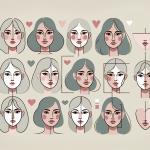Types Of Sleeves
Sleeves are an essential part of any garment. They not only provide functional benefits but also add to the aesthetic appeal of the clothing. The evolution of sleeves in fashion dates back to ancient times, and over the years, various types of sleeves have emerged, each with its unique style and functionality.

The historical evolution of sleeves is a fascinating topic, and it is interesting to note how sleeves have evolved over time. From the simple and practical sleeves of the ancient Greeks to the elaborate and ornate sleeves of the medieval era, sleeves have undergone significant changes. In modern times, sleeves have become a canvas for designers to showcase their creativity and add unique design elements to garments.
In this article, we will explore the different types of sleeves that exist in fashion today. We will discuss the design elements and functional and aesthetic aspects of each type of sleeve, and provide tips on how to choose the right sleeve for your garment. Whether you are a fashion enthusiast or a designer, this article will provide valuable insights into the world of sleeves.
Key Takeaways
- Sleeves have evolved over time and have become an essential part of any garment.
- There are various types of sleeves in fashion, each with its unique style and functionality.
- When choosing the right sleeve for your garment, consider the design elements and functional and aesthetic aspects of each type of sleeve.
Historical Evolution of Sleeves
Sleeves have been an essential part of clothing for centuries, and they have undergone significant changes in terms of design, style, and aesthetics. The evolution of sleeves can be traced back to ancient times, and it continues to shape modern fashion design.
Ancient Styles
In ancient times, sleeves were primarily used for functional purposes, such as protection from the sun and cold weather. The earliest forms of sleeves were simple and loose, covering the arms from the shoulder to the wrist. However, as fashion evolved, sleeves became more elaborate and decorative. In ancient Rome, for example, sleeves were adorned with intricate embroidery and lace, indicating social status and wealth.
In medieval Europe, sleeves were a symbol of power and authority. Nobles and royalty wore long, flowing sleeves that were often embellished with jewels and precious metals. The sleeves were so long that they had to be held up by servants, and they were often used to display wealth and extravagance.
Modern Developments
In the 19th century, sleeves underwent significant changes in terms of design and style. The puff sleeve, for example, was a popular trend during the mid-19th century, particularly in the 1830s and 1890s. The leg-of-mutton sleeves added an exaggerated silhouette to women’s dresses and were often seen as a symbol of femininity and elegance during that era.
As fashion evolved, sleeves became more streamlined and functional. In the 20th century, sleeves were designed to fit the body more closely, providing greater mobility and comfort. Today, sleeves come in a wide variety of styles, including cap sleeves, three-quarter sleeves, and bell sleeves, among others.
In conclusion, sleeves have come a long way from their humble beginnings as functional garments to their current status as a crucial component of fashion design. The historical evolution of sleeves has been shaped by various factors, including social status, aesthetics, and functionality. The design and style of sleeves will continue to evolve over time, reflecting the changing tastes and preferences of fashion-conscious individuals.
Types of Sleeves
When it comes to clothing, sleeves are an essential component of any garment. They not only provide coverage but also add style and personality to the garment. There are many different types of sleeves, each with its unique style and function. In this section, we will explore some of the most common types of sleeves.
Set-In Sleeves
Set-in sleeves are the most common type of sleeve. They are attached to the garment’s armhole and sewn all the way around. Most sleeves, if they are not continuous with the bodice’s fabric are set-in sleeves. They can be long or short, fitted or loose, and made from any kind of fabric. Set-in sleeves are versatile and can be used in a variety of garments, from blouses to dresses.
Raglan Sleeves
Raglan sleeves are a type of sleeve that extends from the neckline to the underarm. They are characterized by a diagonal seam that runs from the underarm to the neckline. Raglan sleeves are often used in sportswear and casual wear, as they provide a comfortable fit and allow for a greater range of motion.
Kimono Sleeves
Kimono sleeves are a type of sleeve that is cut in one piece with the bodice. They are characterized by a wide, square shape that extends from the neckline to the underarm. Kimono sleeves are often used in loose-fitting garments, such as blouses and dresses, as they provide a relaxed, comfortable fit.
Dolman Sleeves
Dolman sleeves are a type of sleeve that is cut in one piece with the bodice. They are characterized by a wide, batwing shape that tapers at the wrist. Dolman sleeves are often used in casual wear, as they provide a comfortable, relaxed fit. They can be made from any kind of fabric and can be long or short.
In conclusion, sleeves are an essential component of any garment, and there are many different types of sleeves to choose from. Set-in sleeves, raglan sleeves, kimono sleeves, and dolman sleeves are just a few examples of the many sleeve styles available. When choosing a sleeve style, it is important to consider the garment’s function, style, and fabric to ensure a comfortable and flattering fit.
Design Elements
Sleeve Lengths
Sleeve length is an essential design element that can change the entire look of a garment. Some common sleeve lengths include short sleeves, three-quarter sleeves, and long sleeves. Short sleeves are perfect for summer wear and casual outfits, while three-quarter sleeves provide a little more coverage and are suitable for transitional seasons. Long sleeves are ideal for colder weather and formal occasions.
Cuffs and Hems
Cuffs and hems are essential design elements that can add structure and style to a sleeve. Cuffs are usually found at the end of a sleeve and can be simple or elaborate. They can be made of the same fabric as the garment or a contrasting fabric. Hems are found at the bottom of a sleeve and can be straight or curved. They can be finished with a rolled hem, a serged edge, or a bias tape.
Decorative Features
Sleeves can have a variety of decorative features that add visual interest and texture to a garment. Ruffles, pleats, and gathers can create a soft and feminine look, while structure and angular lines can create a more modern and edgy look. Some other decorative features include lace, embroidery, and applique. These features can be used to highlight the design, fabric, and fit of the sleeve.
In conclusion, sleeves are an essential design element that can have a significant impact on the overall look and feel of a garment. The length, cuffs and hems, and decorative features are all crucial factors to consider when designing a sleeve. By combining these elements, designers can create unique and stylish sleeves that are both functional and fashionable.
Functional and Aesthetic Aspects
When it comes to sleeves, there are two main aspects to consider: functionality and aesthetics. A sleeve should not only look good but also serve its purpose in terms of comfort and mobility. In this section, we will discuss both aspects in detail.
Comfort and Mobility
The comfort and mobility of a sleeve are crucial factors to consider when choosing a garment. A sleeve that is too tight can restrict movement and cause discomfort, while a sleeve that is too loose can hinder functionality. Therefore, it is essential to choose a sleeve that strikes a balance between the two.
One type of sleeve that offers both comfort and mobility is the raglan sleeve. This type of sleeve extends from the collar to the underarm, allowing for a greater range of motion. Additionally, the raglan sleeve is often used in sportswear, as it offers flexibility and ease of movement.
Another type of sleeve that offers comfort is the kimono sleeve. This sleeve is cut in one piece with the bodice, creating a relaxed and loose fit. The kimono sleeve is often used in casual wear, such as t-shirts and blouses.
Visual Impact
The visual impact of a sleeve can greatly affect the overall silhouette of a garment. Therefore, it is important to choose a sleeve that complements the style and aesthetic of the garment.
One type of sleeve that makes a bold visual impact is the bell sleeve. This sleeve flares out at the bottom, creating a dramatic and voluminous effect. The bell sleeve is often used in formal wear, such as dresses and blouses.
Another type of sleeve that has a visual impact is the bishop sleeve. This sleeve is gathered at the wrist, creating a billowy and romantic effect. The bishop sleeve is often used in bohemian and vintage-inspired garments.
In conclusion, when choosing a sleeve, it is important to consider both functionality and aesthetics. A sleeve that is comfortable and allows for movement can greatly enhance the wearability of a garment, while a sleeve that complements the style and aesthetic can greatly enhance its visual impact.
Choosing the Right Sleeve
When it comes to choosing the right sleeve, there are a few factors to consider. The sleeve style can make a big difference in the overall look and feel of a garment. Here are some things to keep in mind when selecting the perfect sleeve.
According to Body Type
Different sleeve styles can flatter different body types. For example, those with larger arms may want to avoid sleeves that are too tight or short. On the other hand, those with slimmer arms may want to opt for sleeves that add some volume, such as lantern sleeves or bishop sleeves. Raglan sleeves can be a good choice for those with wide shoulders, as they help to balance out the upper body.
Occasion and Garment Type
The occasion and garment type should also be taken into consideration when choosing a sleeve style. For formal events, longer sleeves may be more appropriate, while shorter sleeves can work well for casual occasions. Sleeveless or cap sleeve styles may be ideal for summer dresses or blouses, while coats and jackets may require longer sleeves for warmth.
Fabric Considerations
The type of fabric used for a garment can also impact the sleeve style. Lightweight fabrics such as silk or chiffon may work well with flowy, billowy sleeves, while heavier fabrics like wool or denim may require more structured sleeves. It’s important to consider the drape and weight of the fabric when selecting a sleeve style.
In conclusion, choosing the right sleeve can make a big difference in the overall look and feel of a garment. By considering factors such as body type, occasion and garment type, and fabric considerations, one can select a sleeve style that flatters their figure and complements their outfit.






